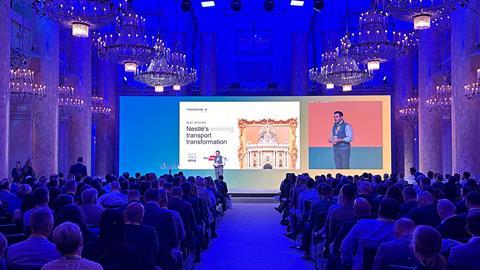Real-time visibility was a key focus at the 2024 Transporeon Summit at the Hofburg Palace in Vienna, where delegates gathered to share ideas and experiences around logistics and supply chain innovation.
Speaking during a panel discussion on the power of collaboration, Tesco project manager Daniel Burgess hailed Transporeon for helping it address customer issues as they occur and therefore manage delivery slots more effectively.
“Real time visibility is going to become more and more key,” Burgess said. “Carriers have been apprehensive but once they use it the drivers can tell our distribution centres what’s happening out on the road.

“So what I’m pushing towards in the next 12 months is not so much looking back but supporting our customer – the receiving depot. A few years ago you had no idea whether the vehicle was going to get there or not until it pulled up at the gate. But we’re getting to a place where we can give our depots a real-time view of what’s happening.”
The supermarket giant works with over 1,000 suppliers and hundreds of hauliers and Burgess said Transporeon’s systems had helped take real-time visibility “to the next level”.
“We can now put driver ETAs into an order so the depot knows they’re expecting, say, 10 vehicles in the hour but only getting three,” he explained. “So we can send the guys who were offloading to do something else and then bring them in when the M25 clears, for example, and they get a deluge of vehicles.
“Optimising our neworks is key. This is about how we reduce road miles. Do we take trucks off the road? Do we put a lot more vehicles on rail? This is all the stuff we’re likely to do in the future. We want to get to a place where we’ve got an optimised network, that’s the nirvana, with a lot more traffic going out on rail. That will make a big difference in the future.”
Procurement was also a major topic at the summit. Ceva Logistics procurement head Jason James, said Transporeon’s Market Insights, which provides data on freight rate trends and cost of ownership, was helping it run operations more effectively.
“We’ve been using Market Insights for three or four years to make sure we’re doing the right things for our carriers and customers,” he said. “We’ve invested a lot in procurement, it’s really becoming a major opportunity for us now.
“We’re using it firstly for spot against contract, and obviously there’s been a lot of changes in the trends over the last year or so. Last year we were seeing the spot price significantly lower than the contract and now it’s levelling out. So we use it to make decisions on whether we need it to arrange a tender. Do we need to do benchmarking to make sure we’re in the correct place? But it’s not always about being the cheapest, it’s about being competitive, so that’s the main goal.”
James said Tranporeon had helped Ceva to identify rates and and pricing trends: “We can see if we’re at the right price in the market and have the right deals with our carriers,” he explained. “We need to make sure we’re doing the right thing by our customers. Do we need to adapt where our rates are too high or too late? We want to make sure we give customers security. It enables us to react to the market and the way conditions are going.”
Asked about the current market climate, James said: “At the moment the expectancy is that volumes are still down but we’ve got a driver shortage and we’ve got some carriers taking capacity out of the market. That’s giving us another challenge that will probably go into next year.”















![DHL SC Tesco Ireland[77612]](https://d2cohhpa0jt4tw.cloudfront.net/Pictures/100x67/7/3/1/18731_dhlsctescoireland77612_582346.jpg)